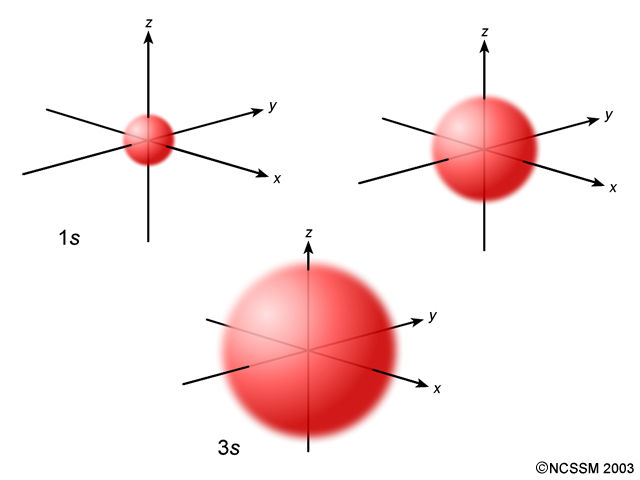BOHR THEORY
- the electron is a particle that must be in orbital in the atom
QUANTUM THEORY
- the electron is like a cloud of negative energy or a wave
- the electron wave stays in certain orbitals
- orbitals are areas in 3D space where the electrons most probably are (*Note: we can never be 100% sure the electron is exactly in a certain place, since it is said to be a wave of energy)
- the energy of the electron is in its vibrational modes (like notes on a guitar string)
- photons are produced when high energy modes change to lower energy modes (Example: energy from the electron is released as light, aka a photon)
The orbitals contain electrons moving around in that area. The orbitals may overlap eachother; the differences between the orbitals (as we know so far) is that they can be larger spaces, smaller spaces, or situated in different sides.
(*Note: ignore the numbers and words on the pictures. The pictures are just examples of where the orbitals may be situated in the atom.)
S Orbitals
- there is 1 suborbital
- each orbital holds 2 electrons
- total electrons: 2

P Orbitals
- there are 3 suborbitals
- each containing 2 electrons
- total electrons: 6

D Orbitals
- there are 5 suborbitals
- each contains 2 electrons
- total electrons: 10

F Orbitals
- there are 7 suborbitals
- each contains 2 electrons
- total electrons: 14

How the orbitals correspond to the periodic table and elements:

*Note: if an element is under, let's say "2p", it has all the other orbitals filled too, so that would be 1s, 2s, 2p. Geddit?
For Bohr models, we know we draw engery levels and little dots for electrons.
For Lewis Diagrams, we graw the outer shell with dots for electrons.
So how do we express a certain element with it's electrons using this Quantum Mechanic theory?
Example:
Fluorine
1) Find the element on the periodic table
2) Figure out how many orbitals its electrons take up (you can use the previous chart to figure this out, just match the positions!)
So, it's in the 2p section, which means its electrons take up the orbitals 1s, 2s, 2p
3) Next, find out how many electrons it has and figure out how many are in each orbital
Fluorine has 9 electrons
(Since each S orbital can hold 2 electrons...)
(Since each S orbital can hold 2 electrons...)
1s holds a max. of 2 electrons
2s holds a max. of 2 electrons
(Since each P orbital can hold 6 electrons...)
2p holds a max. of 6 electrons
So Fluorine would look like:
1s(2) 2s(2) 2p(5)
(*bracket numbers = the number of electrons in each orbitals)
And you're done!
Try it out using Sodium
Highlight for answer: 1) 1s(2)2s(2)2p(6)


No comments:
Post a Comment